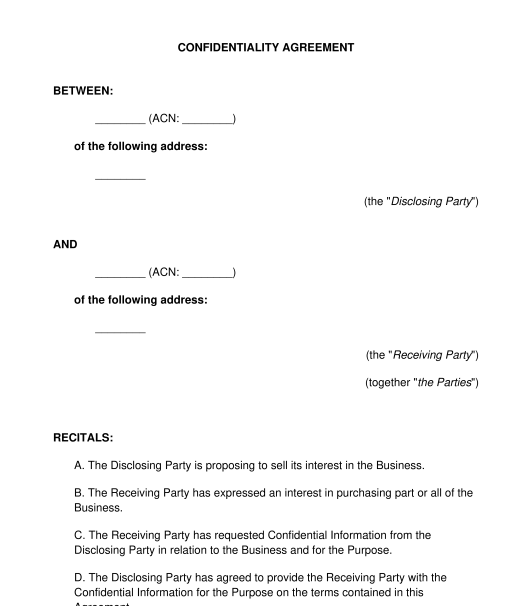 06/09/2025
06/09/2025

Answer a few questions and your document is created automatically.

Your document is ready! You will receive it in Word and PDF formats. You will be able to modify it.




Rating: 4.7 - 59 votes
Fill out the templateA Confidentiality Agreement, also known as a Non Disclosure Agreement or NDA is a commercial agreement between two people or companies where the parties agree to protect the Confidential Information of one or both of the parties.
Non-Disclosure Agreements or Confidentiality Agreements generally enable parties to reveal information with commercial value that they might otherwise keep secret, so that commercial negotiations can continue openly and honestly.
Confidentiality Agreements usually include a description of confidential information. It generally refers to information that is sensitive to one of the parties and that they want to protect. For example, it could include trade secrets like recipes or formulas, intellectual property, customer lists, sales data, financial records, and customers' personal information.
A Confidentiality Agreement usually cannot protect information that is already public knowledge.
When a person or organisation is planning to share some confidential information with another person or organisation, it is a good idea to use a Confidentiality Agreement or NDA.
The two main types of Confidentiality Agreement are:
A Confidentiality Agreement and a Non-Disclosure Agreement or NDA are really just different names for the same kind of document.
However, in practice, people often use the name "Confidentiality Agreement" when they want a longer and more comprehensive document. For example, if two companies are considering working together on a joint project and sharing a large amount of sensitive financial information, they might want a Confidentiality Agreement. On the other hand, if the parties are just having preliminary discussions and want a quick document to sign before their first meeting, then they might want a Non-Disclosure Agreement.
While both documents impose some restrictions on the parties, they deal with different subject matter.
No, but if a person or business is sharing confidential information, then a written Confidentiality Agreement makes it much easier to protect that information.
A Confidentiality Agreement should not prevent a person from reporting a crime or regulatory concern, or safety concern - for example, if an employee sees that their employer is breaking the law, breaking environmental regulations or the employee notices a health and safety issue at work.
Companies or individual people can enter a Confidentiality Agreement.
To enter into a Confidentiality Agreement, a person should be aged 18 or older and should have the mental capacity to understand what they are doing.
In some cases, if confidential information is being shared with a company, then the party that is sharing that confidential information will insist that the company also makes sure that its employees understand their confidentiality obligations and sign equivalent Confidentiality Agreements.
The duration (also known as the term) of a Confidentiality Agreement is often between one and three years. The term could be related to the duration of the relationship between the parties (for example, for the duration of an employment relationship, and then for another one year after that).
The term can be made longer than three years if required, but if it is unlimited, then there is a risk that courts will decide this is unreasonable.
A Confidentiality Agreement can be struck down by a court if it is found to be unreasonably restrictive.
Once a Confidentiality Agreement is ready each party should take the time to review it and make sure they understand it. They should also have the opportunity to obtain legal advice if required.
Once the parties are happy with the Agreement, they should sign it. They should both keep a signed copy for their own records.
A Confidentiality Agreement should contain:
There is no law or regulation governing the use or terms of Confidentiality Agreements in Australia. The broad principles that apply to contract and restraints of trade are applicable to this Confidentiality Agreement.
You fill out a form. The document is created before your eyes as you respond to the questions.
At the end, you receive it in Word and PDF formats. You can modify it and reuse it.
Guides to help you
Confidentiality Agreement - sample template
Country: Australia